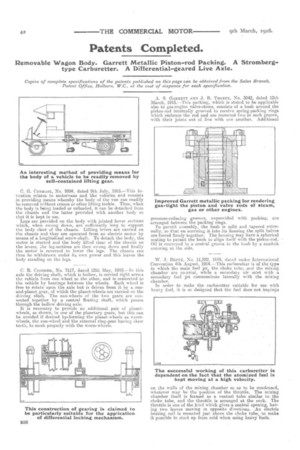Patents Completed.
Page 22

If you've noticed an error in this article please click here to report it so we can fix it.
Removable Wagon Body. Garrett Metallic Piston-rod Packing. A Strombergtype Carburetter. A Differential-geared Live Axle.
Copies of complete specifications of the patents published on this page can be obtained from the Sales Branch, Patent Office, Holborn, W.C, at the cost of sixpence for each specification.
C. G. CONRADi, No. 9994, dated 9th July, 1915.—This invention relates to motorvans and like vehicles and consists in providing means whereby the body of the van can readily be removed without cranes or other lifting tackle. Thus, when the body is being loaded or unloaded, it can be detached from the chassis and the latter provided with another body so that it is kept in use. Legs are provided on the body with jointed lower sections which, when swung down, are sufficiently long to support the body clear of the chassis. Lifting levers are carried on the chassis and they are operated from an electric motor by means of a longitudinal sew-shaft.. To detach the body, the motor is started and the body lifted clear of the chassis on the levers, he leg-sections are then swung down and finally the motor is reversed to lower the legs. The chassis can then he withdrawn under its own power and this leaves the body standing on the legs.
C. R. CROSITER, No. 7117,, dated 12th May, 1915.—In this axle the driving shaft, which is hollow, is carried right across the vehicle from one wheel to the other, and is connected to the vehicle by bearings between the wheels. Each wheel is free to rotate upon the axle but is driven from. it by a sunand-planet gear, of which the planet-wheels are carried on the driving shaft. The sun-wheels of the two gears are connected together by a central floating shaft, which passes through the hollow driving axle.
It is necessary to provide an additional pair of planetwheels, as shown, in one of the planetary gears, but this can be avoided if desired hyviorming the planet-wheels as wormwheels, the sun-wheel and the external ring-gear having skew teeth, to mesh properly with the Worm-wheels.
A. S. CiAIM= _AND J. R. TiloRPE, No. 3942, dated 12th March, 1915,—This packing, which is stated to be applicable also to gaszengine valve-stems, consists of a bush around the piston-rod internally grooved to receive spring-packing rings which embrace the rod and are mounted two in each graove, with their jeints out of lice with one another. Additional
pressure-reducing grooves, unprovided with packing, arc arranged between the packing rings.
To permit assembly, the bash is split and tapered exter, nally, so that on screwing it into its housing the split halves are forced firmly together. The housing may have a spherical seating to permit the bush to align itself with the piston-rod. Oil is conveyed to a central groove in the bush by a conduit entering at the side.
W. .T. DErrE, No. 11,222. 1915, dated under International Convention 4th August, 1914.—This carburetter is of the type in which the main fuel jet, the choke tube; ..and the mixing chamber are co-axial, while a secondary air inlet with a secondary fuel jet communicate laterally with the mixing chamber.
In order to make the carburetter suitable for Use With heavy fuel, it is so designed that the fuel does not inipinge on the walls of the mixing chamber so as to be condensed, whatever may be the position of the throttle. The mixing chamber itself is formed as a venturi tube similar to. the choke tube, and the throttle is arranged at the neck. Tho throttle is one of the kind Which gives a central opening, hay. lug two leaves moving in opposite directions. An electric heating coil is mounted just above the choke tube, to make it possible to start up from cold when using haivy fuels.






















